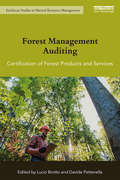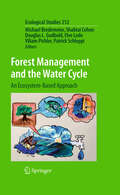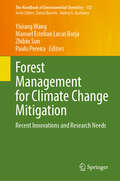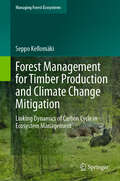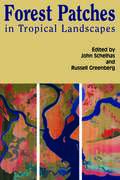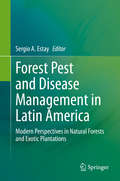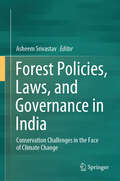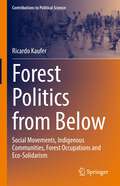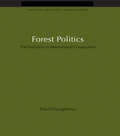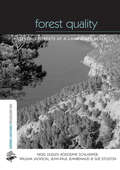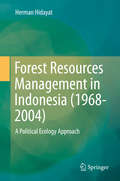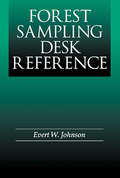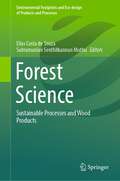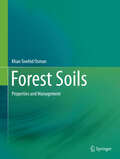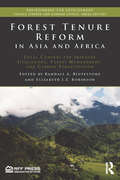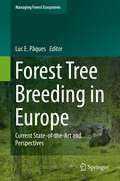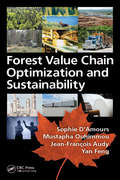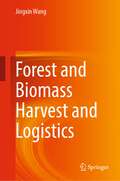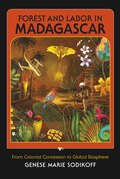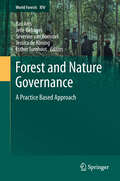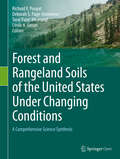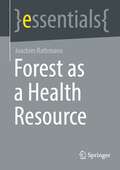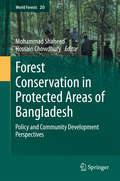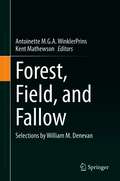- Table View
- List View
Forest Management Auditing: Certification of Forest Products and Services (Earthscan Studies in Natural Resource Management)
by Davide Pettenella Lucio BrottoForest management auditing is expanding from its traditional focus on forest management, stewardship and Chain of Custody certification to more innovative topics such as ecosystem services, forest carbon credits, Non-Wood Forest Products, wood energy and Fair Trade certification. Forest managers, auditors and project developers require a new range of skills, capacities and expertise to monitor these issues. This book outlines the market-based tools that are required by such professionals to ensure corporate social responsibility in the forestry sector. It shows how a mutual learning process between established forest certification processes and innovative markets is needed. It addresses key topics such as High Conservation Value (HCV) approaches, the role of independent certification versus due diligence process and the engagement of smallholders and SMEs. Beginning with a market and policy analysis, the book fosters a deeper understanding of standards, methodologies and auditing techniques. Numerous case studies are included from a wide range of contexts, including both temperate and tropical forests in developed and developing countries. Overall, the book analyses all the steps towards forest management and forest products and services certification.
Forest Management and the Water Cycle
by Douglas L. Godbold Michael Bredemeier Patrick Schleppi Shabtai Cohen Viliam Pichler Elve LodeThe protective function of forests for water quality and water-related hazards, as well as adequate water supplies for forest ecosystems in Europe, are potentially at risk due to changing climate and changing land-management practices. Water budgets of forest ecosystems are heavily dependent on climate and forest structure. The latter is determined by the management measures applied in the forestry sector. Various developments of forest management strategies, imposed on a background of changing climate, are considered in assessing the overall future of forest-water interactions in Europe. Synthesizing recent research on the interactions of forest management and the water regime of forests in Europe and beyond, the book makes an important contribution to the ongoing dialogue between scientists dealing with different scales of forest-water interactions. This collaborative endeavour, which covers geographic and climatic gradients from Iceland to Israel and from southern Spain to Estonia and Finland, was made possible through the COST Action "Forest Management and the Water Cycle (FORMAN)", which was launched in 2007 (http://www.forestandwater.eu/). The book will be of particular interest to the research community involved in forest ecosystem research and forest hydrology, as well as landscape ecologists and hydrologists in general. It will also provide reference material for forest practitioners and planners in hydrology and land use.
Forest Management for Climate Change Mitigation: Recent Innovations and Research Needs (The Handbook of Environmental Chemistry #132)
by Paulo Pereira Yixiang Wang Manuel Esteban Lucas Borja Zhibin SunThis book reviews the most recent research on soil, vegetation, and ecosystems within forestry landscapes under the pressures of climate change. It also explores the interplay between climate change, forest ecology, and human interventions. Covering a diverse array of topics such as carbon sequestration, wildfire impacts, soil biogeochemistry, and methane emissions, the book incorporates scientific research and management strategies to provide a holistic understanding of the challenges and opportunities for forest management amidst climate change. In this book, readers will find the most up-to-date afforestation and forest management techniques for controlling greenhouse gas (GHG) emissions and carbon sequestration in the forestry system. The readers of this book will gain a new perspective on forests by learning about new forestry techniques, forest vegetation change, natural and artificial disturbances, soil greenhouse gases, and soil chemistry, all while emphasizing the critical relationship between Environmental Chemistry and Forestry. Focusing on the practices of the Asia-Pacific Network for Sustainable Forest Management and Rehabilitation (APFNet) Projects, the book offers insights into practical approaches and solutions for addressing climate change within forest ecosystems and provides evidence-based recommendations for sustainable forest management and adaptation strategies. This unique volume, which includes contributions from respected scholars, emphasizes the importance of interdisciplinary collaboration in addressing the complex challenges posed by climate change in forest ecosystems. It also aims to raise awareness among forestry researchers, officials, and policymakers about the growing importance of forest ecosystems as a result of global climate change.
Forest Management for Timber Production and Climate Change Mitigation: Linking Dynamics of Carbon Cycle in Ecosystem Management (Managing Forest Ecosystems #44)
by Seppo KellomäkiThis book introduces the complex world of carbon dynamics within forest ecosystems, particularly in boreal zones, while also incorporating findings from selected temperate areas. It explores how these dynamics are influenced by management strategies and operations, providing a comprehensive understanding of how forests can be managed to enhance carbon uptake and thus, mitigate climate change. Divided into five parts, the volume begins by addressing the characteristics of global and boreal forests and their contribution to carbon storage. The following sections explore carbon dynamics in both natural and managed forests, including their impact on forest succession. The text also examines how management practices affect carbon dynamics, tree growth, and carbon stocks. Strategies to mitigate climate change through forest management, including the management of soil carbon and reforestation efforts are discussed. Finally, topics such as pre-commercial management, commercial thinning, and forest fertilization and their roles in managing boreal forest ecosystems for carbon sequestration and climate benefits are addressed. Aimed at professionals, researchers, and students in forestry, environmental science, and climate change studies, this book provides valuable insights into developing management strategies that enhance carbon uptake and accumulation in forest ecosystems. Readers will gain a comprehensive understanding of how forest management can contribute to climate change mitigation. It is an essential resource for anyone interested in sustainable forestry practices.
Forest Patches in Tropical Landscapes
by John Schelhas Russell S. Greenberg"While tropical forests are being cleared at an alarming rate, the clearing is rarely complete and is often not permanent. A considerable amount of tropical forest exists as remnants that have significant value both for the conservation of biological diversity and for meeting the needs of local people.This volume brings together world-renowned scientists and conservationists to address the biological and socio-economic value of forest remnants and to examine practical efforts to conserve those remnants. An outgrowth of a year-long study by the policy program at the Smithsonian Migratory Bird Center, Forest Patches in Tropical Landscapes provides a broad overview of theory and practice, and will help foster both interdisciplinary research and more effective approaches to tropical conservation and development.
Forest Pest and Disease Management in Latin America: Modern Perspectives in Natural Forests and Exotic Plantations
by Sergio A. EstayBy providing multiple economic goods and ecosystem services, Latin American forests play a key role in the environmental, social and economic welfare of the region’s countries. From the tropical forests of Central America to the Mediterranean and temperate vegetation of the southern cone, these forests face a myriad of phytosanitary problems that negatively impact on both conservation efforts and forest industry. This book brings together the perspectives of several Latin American researchers on pest and disease management. Each chapter provides modern views of the status and management alternatives to problems as serious as the impact of introduced exotic insects and diseases on Pinus and Eucalyptus plantations throughout the continent, and the emergence of novel insect outbreaks in tropical and temperate native forests associated with global warming. It is a valuable guide for researchers and practitioners working on forest health in Latin America and around the world.
Forest Policies, Laws, and Governance in India: Conservation Challenges in the Face of Climate Change
by Asheem SrivastavThe book delves into the intricate relationship between India’s forest governance, laws, and policies over time, examining their effects on the quality and coverage of the country’s forests. Historically, especially during the British era and the initial phase following independence, forests were valued for timber, leading to increased deforestation to fulfill the rising demands of shipbuilding, railways, residential construction, and industry. The economic benefits derived from converting forest land for developmental purposes were a key factor in this trend. However, recent statistics indicate that except Maharashtra, most of the forest rich states including MP and Chhattisgarh have lagged in economic development. The history of overexploitation and diversion for non-forestry use has also led to less forest area per capita. India has lost tree biomass much more than its productivity potential, and the average biological productivity of Indian forest is much below the global average. It is extremely important to restore the health of natural forests which are, by far, the best and a highly cost-effective carbon sequestering machine provided by nature. The book also provides research data, both at national and global scales to convincingly put forward the contention that natural forests are sine qua non and under no circumstances can farm and roadside plantations, tea and coffee plantations, and orchards be a substitute for natural forest for three important reasons: (1) the influence of natural forest on rainfall, (2) the complexity in maintaining energy flow, and (3) the impact of natural forest or deforested sites on soil.
Forest Politics from Below: Social Movements, Indigenous Communities, Forest Occupations and Eco-Solidarism (Contributions to Political Science)
by Ricardo KauferThis book presents an analysis of forest politics that employs a broader scope to include non-institutionalized actors. It offers a comparative perspective on various environmental social movements fighting to protect forests around the globe, including indigenous communities in the Amazon and eco-anarchists in Europe. By examining the political goals, motives, and tactics of these sometimes-radical environmentalists, it helps readers understand the commonalities and differences among these “grass-roots forest politicians.” In addition, the book highlights the importance of forest-related struggles for a just transition to a carbon-neutral future. Accordingly, it will appeal to scholars of political science, public policy, and political sociology, as well as anyone interested in social movements and forest conservation.
Forest Politics: The Evolution of International Cooperation (Natural Resource Management Set Ser.)
by David Humphreys'An important and timely book' from the Foreword by Stanley Johnson 'A complete and absorbing history of a decade of intense international politics offers many insights for future negotiators of sustainable solutions' Stephen Bass, International Institute for Environment and Development 'Skillfully navigates the jungle of forest politics, leaving us in no doubt that the verbal commitment to save the world's forests has yet to be translated into action on the ground. The way forward must clearly lie in political commitments and international cooperation if forests are to continue to preserve life on Earth' Francis Sullivan, World Wide Fund for Nature Global deforestation and its attendant processes - including soil degradation, climate change and the loss of biological diversity - emerged as international political issues during the 1980s, prompting politicians to seek consensus on programmes and policies for the conservation and sustainable management of forests. Yet global initiatives have been bedevilled by tensions between the North and South and between governments, industry, local communities and indigenous peoples. Meanwhile, rates of deforestation in the tropics are increasing, and international political efforts are demonstrably failing. Forest Politics carefully traces the evolution of international cooperation on forests, from the inception of the controversial International Tropical Timber Organization and the failed Tropical Forestry Action Programme in the mid-1980s, to the creation of the Intergovernmental Panel on Forests in the mid-1990s. The book also provides a detailed analysis of the negotiating stances of the parties involved in the divisive negotiations that rook place prior to the 1992 'Earth Summit' in Rio de Janeiro and the equally factious negotiations for the International Tropical Timber Agreement of 1994. It provides a fascinating insight into the nature of such processes, illustrating the difficulties that arise when concepts such as 'global commons' come into conflict with national sovereignty. Complete with annexes of important political documents, and making extensive use of primary source material and interviews with participants. Forest Politics presents case studies of all the major forest negotiations over the last 13 years. It is an essential reference point for policy makers, environmental campaigners and students, and required reading for all those who care about the future of the world's forests. David Humphreys is Research Fellow in Global Environmental Change at the Open University. Originally published in 1996
Forest Quality: Assessing Forests at a Landscape Scale (The Earthscan Forest Library)
by William Jackson Jean-Paul Jeanrenaud Nigel Dudley Sue Stolton Rodolphe SchlaepferDeforestation is frequently a topic of discussion in the environmental arena, but it is not just the number of trees that matters; the quality of the forest is also important. Even where the forest area is stable or increasing, there are often rapid changes in its character. Natural forests are being replaced by plantations or by intensively managed forests. Around the world, forests are becoming younger and less diverse, in both species and structure; this has important impacts for biodiversity and also affects many human values. In this groundbreaking text, forest quality is discussed as a useful new concept in forest conservation and management. Three main assessment criteria are used: authenticity; environmental benefits; and social and economic benefits. The book describes a methodology and protocol for collecting and analysing data, and outlines in detail the approach required with each indicator. The authors advocate a landscape approach to assessment and demonstrate how assessment works through a series of case studies that show how this approach can be used in many ways to help forest conservation management. This hands-on manual is for professionals involved in forestry, conservation and resource management worldwide, and contains case study material from Europe, Asia, Africa and Latin America that demonstrates practical uses of the new 'landscape' approach to forest conservation. Published with IUCN and WWF
Forest Radioecology in Fukushima: Radiocesium Dynamics, Impact, and Future
by Shoji Hashimoto Masabumi Komatsu Satoru MiuraThis is an open access book that provides holistic information on the radioactive contamination of forests. Topics are highly interdisciplinary, ranging from the dynamics of radioactive cesium in forest ecosystems to the radiation protection or the socio-economic aspects of radiation effects. It is designed to help people understand the radioactive contamination in forests and provide hints of how to cope with it and restore their livelihoods. The book is characterized by its well-balanced structure that allows the reader to understand the whole picture without going into too much scientific content. After explaining the basics of radioactive materials and radiation, the book illustrates the radioactive contamination of forests, it also describes the impacts on the forestry and life of local people and the measures taken by. Few books address the concerns about how to deal with radioactive contamination of forests and the future perspectives. In this book, people can learn all about the Fukushima nuclear accident of forests, forest products, and people with abundant reference materials. In addition, the book contains four memoirs contributed by Japanese and European researchers that graphically record what the researchers thought and how they acted in the chaos of the aftermath of the accident. In 2021 that marking the 10th anniversary of the Fukushima nuclear accident and the 35th anniversary of the Chernobyl accident, nuclear disasters are in the spotlight more than ever. This thought-provoking book on how to prepare for a severe nuclear accident is suitable for sharing with people all over the world as a lesson on the next nuclear accidents, now that the number of nuclear power plants is still increasing. The translation of this work was done with the help of artificial intelligence (machine translation by the service DeepL.com). Intensive improvements were subsequently made by the authors throughout the text to ensure accuracy of expression and contents and to enhance the clarity.
Forest Resources Management in Indonesia (1968-2004)
by Herman HidayatThis book explores the forestry sector and its context, investigating the management of forest resources in Indonesia. It covers topics including forest fires, deforestation, water pollution, depletion of biodiversity, climate change and environmental damages. The book adopts a political economy approach, elaborating on the role of direct actors such as the central government, private companies and local governments, and the role of indirect actors. In addition, readers will discover anthropological and sociological perspectives through engagement with local communities such as the Kutai, Banjar and Rejang ethnic groups, Chinese trading communities, NGOs and Academics. Featuring interviews with 91 informants and participatory observations, the text draws on secondary literature to provide a comprehensive overview of the subject. This work is illustrated with figures, tables and maps and will be of particular interest to students and researchers of forest policies. It makes a valuable contribution to forest sciences and will also be useful to those in non-government organizations, politicians and business men with an interest in forest resources management, or a deeper interest in Indonesia.
Forest Sampling Desk Reference
by Evert W. JohnsonShould damaged trees be clear cut and replanted or allowed to recover naturally? Is the deer herd large enough to survive hunting pressure? Managing forest resources entails numerous decisions. Making these decisions intelligently requires sound information about the resource in question. Ideally, assessments should be based on the entire populatio
Forest Science: Sustainable Processes and Wood Products (Environmental Footprints and Eco-design of Products and Processes)
by Subramanian Senthilkannan Muthu Elias Costa de SouzaThis book highlights the sustainability aspects of products and processes in forest science. The forest products sector supplies raw materials to several industrial sectors worldwide. These products can be classified as timber or non-timber products. Wood products are those that originate from the woody fraction and can include pulp, charcoal, firewood, and others. The non-timber products, on the other hand, have the products extracted from the different parts of the tree, such as bark, leaves, fruits, resins, oils, tannins, or even products extracted from non-woody biomass, such as palm heart or carnauba, among others. There are new studies and new products developed from forests worldwide each day. However, studies that evaluate the sustainability of these products and the processes related to their production are not so common. It is essential to highlight the sustainability aspects of these activities and the products obtained from them; such that steps can be taken to make the processes eco-friendly. Allied to ecological sustainability studies that evaluate the technical and economic feasibility of such activities arise. With this book, the authors through the approach of other products and processes of forest science, present the practical vision of aligning production with sustainability in an economically viable way. The book analyses different products and processes, ranging from technological production of engineered wood products to handcrafted resins with a high commercial appeal. With the expertise of different authors, who are researchers in various specific areas of forest sciences, this book helps expand research and presents new insights, assisting industry decision-makers and researchers working in the areas forest sciences.
Forest Soils
by Khan Towhid OsmanForest soil characteristics are not only unique but their interpretation also differs from cropland soils. Just as there are diverse forest types, there are many soil variants that need different management. Today, forest plantations are being intensively managed for profitable timber, pulpwood and energy production. Site selection, species selection, site productivity evaluation, silvicultural treatments, and soil amendments need crucial soil information. This book provides a comprehensive overview of the physical, chemical and biological properties of forest soils and their implications on forest vegetation. Topics discussed include: major forest types of the world and their associated soils; forest biomass and nutrient dynamics; organic matter turnover and nutrient recycling; forest soil disturbance; forest soil and climate change; and forest soil management and silvicultural treatments.
Forest Tenure Reform in Asia and Africa: Local Control for Improved Livelihoods, Forest Management, and Carbon Sequestration (Environment for Development)
by Randall Bluffstone Elizabeth J.Z. RobinsonForest tenure reforms are occurring in many developing countries around the world. These reforms typically include devolution of forest lands to local people and communities, which has attracted a great deal of attention and interest. While the nature and level of devolution vary by country, all have potentially important implications for resource allocation, local ecosystem services, livelihoods and climate change. This book helps students, researchers and professionals to understand the importance and implications of these reforms for local environmental quality, climate change, and the livelihoods of villagers, who are often poor. It is shown that local forest management can often be more successful than top-down management of common pool forest resources. The relationship of local forest tenure reform to the important climate change initiative REDD+ is also considered. The work includes a number of generic chapters and also detailed case studies from China, Ethiopia, Kenya, Nepal, Tanzania and Uganda. Using specific examples and a wide variety of disciplinary perspectives, including quantitative and qualitative analytical methods, the book provides an authoritative and critical picture of local forest reforms in light of the key challenges humanity faces today.
Forest Tree Breeding in Europe: Current State-of-the-Art and Perspectives
by Luc E PâquesForest tree breeding has been ongoing for more than 70 years across Europe. It has successfully generated improved varieties for the major economical forest tree species. They are part of the present European forestry landscape and largely contribute to intensive wood production and other forest activities. In this book, we describe the state-of-art of breeding for the main forest tree species. We provide a comprehensive, unique and up-to-date overview of the major scientific results and breeding achievements gathered from the many programmes scattered across Europe. The book is divided into 10 chapters, each as a monograph corresponding to a species or group of species Abies spp., (Larix spp., Picea abies, Picea sitchensis, Pinus sylvestris, Pseudotsuga menziesii, and Mediterranean pines; Acer pseudoplatanus, Fraxinus excelsior, and Prunus avium). Each of them is written by a group of experts and focuses on the distribution and economical importance of the species; motivation for breeding and breeding objectives; intraspecific genetic variability, breeding populations and breeding strategy; forest reproductive material deployment including mass-propagation and, prospects and perspectives for joint research and breeding. The book is a unique and up-dated source of information for students, researchers and professionals interested in the genetics and domestication of forest tree species.
Forest Value Chain Optimization and Sustainability
by Sophie D’Amours, Mustapha Ouhimmou, Jean-François Audy and Yan FengThis book provides a global perspective on the various issues that the industry has to face as well as to provide some key global strategies that can help coping with those global challenges, such as collaboration, strategic value chain planning, and interdependency analyses. It presents literature reviews, strategic research orientations, assessment of some current key issues, and state-of-the-art methodologies.
Forest and Biomass Harvest and Logistics
by Jingxin WangThis book explains forest and woody biomass harvest, harvesting machines, systems, logistics, supply chain management, best management practices, harvest scheduling and carbon sequestration. It also covers applications of harvesting principles in forest and biomass management practices. The book provides an in-depth understanding of functions and applications of current and future harvesting technologies, the unique characteristics of harvesting machine with respect to cost, productivity, and environmental impacts. Special features include harvest machine illustrations and images of field operations, tabular presentations of filed studies of forest operations and detailed modelling processes for forest and biomass harvest logistics and supply chain management. Specifically, the book is designed for students, researchers, educators, and practitioners in the field of forest and biomass harvest and logistics. The book’s contents have been tested in teaching as the Harvesting Forest Product class for undergraduates and graduates in the Division of Forestry and Natural Resources at West Virginia University since 2000. The information contained in this book is a robust reference resource for students who would be future forest and biomass managers, timber contractors, entrepreneurs, researchers, and educators in the fields of forest and biomass operations, engineering, and resource management.
Forest and Labor in Madagascar: From Colonial Concession to Global Biosphere
by Genese Marie SodikoffA study of the demands of economic development and ecological conservation on the African island country.Protecting the unique plants and animals that live on Madagascar while fueling economic growth has been a priority for the Malagasy state, international donors, and conservation NGOs since the late 1980s. Forest and Labor in Madagascar shows how poor rural workers who must make a living from the forest balance their needs with the desire of the state to earn foreign revenue from ecotourism and forest-based enterprises. Genese Marie Sodikoff examines how the appreciation and protection of Madagascar’s biodiversity depend on manual labor. She exposes the moral dilemmas workers face as both conservation representatives and peasant farmers by pointing to the hidden costs of ecological conservation.“Sodikoff takes us deep into the underbelly of conservation in one of the world’s biodiversity “hot-spots.” It is a world of timber barons, logging gangs, corrupt state functionaries, international conservation experts, worker-peasants, and poachers. She paints eastern Madagascar as a frontier of dispossession, exploitation, and violence. The plundering of the Mananara protected area is seen, in a brilliantly original way, from the subaltern vantage point of forest workers and conservation labor. Forest and Labor places present day conservation on the larger canvas of a century of forest-based social relations of labor that have entered into the making of what Sodikoff calls neoliberal conservation. It is a magnificently rich historical and ethnographic accounting of what passes as the making of global biosphere reserves. A tour de force.” —Michael Watts, UC Berkeley“An important and lively contribution to the study of “green neoliberalism.” An obvious choice for undergraduate teaching on ecology, rights, international political economy, development, and a host of other topics.” —David Graeber, University of London“Brings a whole new angle and nuance to the crucial debates over conservation and development. Applicable not just to lush, humid eastern Madagascar, but all around the globe.” —Christian Kull, Monash University“Those interested in conservation, tropical rainforest ecology, international political economy, and sustainable development will find Forest and Labor in Madagascar an insightful case study.” —Choice
Forest and Nature Governance
by Jelle Behagel Bas Arts Jessica De Koning Esther Turnhout Séverine Van BommelToday, problems such as deforestation, biodiversity loss and illegal logging have provoked various policy responses that are often referred to as forest and nature governance. In its broadest interpretation, governance is about the many ways in which public and private actors from the state, market and/or civil society govern public issues at multiple scales. This book takes a fresh perspective on the study of forest and nature governance. Departing from 'practice theory', and building upon scholars like Giddens, Bourdieu, Reckwitz, Schatzki and Callon, it seeks to move beyond established understandings of institutions, actors, and knowledge. In so doing, it not only presents an innovative conceptual and methodological framework for a practice based approach, but also rich case studies and ethnographies. Finally, this book is about how actors involved in governance talk about and work with trees, forests, biodiversity, wildlife, and so on, while acting upon forest policies, environmental discourses, codes of conduct, or scientific insights.
Forest and Rangeland Soils of the United States Under Changing Conditions: A Comprehensive Science Synthesis
by Toral Patel-Weynand Richard V. Pouyat Deborah S. Page-Dumroese Linda H. GeiserThis open access book synthesizes leading-edge science and management information about forest and rangeland soils of the United States. It offers ways to better understand changing conditions and their impacts on soils, and explores directions that positively affect the future of forest and rangeland soil health. This book outlines soil processes and identifies the research needed to manage forest and rangeland soils in the United States. Chapters give an overview of the state of forest and rangeland soils research in the Nation, including multi-decadal programs (chapter 1), then summarizes various human-caused and natural impacts and their effects on soil carbon, hydrology, biogeochemistry, and biological diversity (chapters 2–5). Other chapters look at the effects of changing conditions on forest soils in wetland and urban settings (chapters 6–7). Impacts include: climate change, severe wildfires, invasive species, pests and diseases, pollution, and land use change. Chapter 8 considers approaches to maintaining or regaining forest and rangeland soil health in the face of these varied impacts. Mapping, monitoring, and data sharing are discussed in chapter 9 as ways to leverage scientific and human resources to address soil health at scales from the landscape to the individual parcel (monitoring networks, data sharing Web sites, and educational soils-centered programs are tabulated in appendix B). Chapter 10 highlights opportunities for deepening our understanding of soils and for sustaining long-term ecosystem health and appendix C summarizes research needs. Nine regional summaries (appendix A) offer a more detailed look at forest and rangeland soils in the United States and its Affiliates.
Forest as a Health Resource (essentials)
by Joachim RathmannJoachim Rathmann presents the interdisciplinary links between forests and human health. Forests provide numerous ecosystem services for the survival, well-being, and maintenance and enhancement of human health. Forests provide multisensory recreational spaces and can therefore be considered a resource that positively impacts both physical, mental, and social aspects of health. The author presents natural science, social science, and humanities research in an understandable, clear, and concise manner for a diverse readership.
Forest conservation in protected areas of Bangladesh
by Mohammad Shaheed Hossain ChowdhuryThis book dealt with a number of issues under the broad subject matter of protected area focusing on the policy of collaborative management as a means to augment the forest conservation activities and enhance community development in Bangladesh. Studies covered in the book emerged with the success stories of protected area co-management, both in terms of community development and biodiversity conservation. Significant level of development was noticed in the socio-economic conditions of the surrounding communities. Empowerment and improved social dignity of women participants signifies the initiation of co-management approach. The principles of participatory governance were found reasonably well reflected in legal and policy frameworks. Based on the lessons from the studies, a general metaphysical model, namely 'Spider-web model of protected area co-management' has been developed that can be potentially applicable in countries where local communities rely heavily on protected areas.
Forest, Field, and Fallow: Selections by William M. Denevan
by Kent Mathewson Antoinette M. G. A. WinklerPrinsThis volume aims to present the essential work of geographer and historical ecologist William M. Denevan to explain the impact and influence his thinking had on the conceptual advancement not only in his own discipline, but in a range of related disciplines such as anthropology, archaeology, and environmental history. The book is organized around eight themes, demonstrating Denevan’s early and profound insights on topics that remain of current relevance today, and the scholarly impact his writing had on subsequent scholarship. The book is unique because it offers commentary from active scholars who address the impacts of Prof. Denevan's thinking and work on contemporary environmental and ecological issues, with a focus on several groundbreaking themes (e.g. historical demography, agricultural landforms, cultural plant geography, human environmental impacts, indigenous agro-ecology, tropical agriculture, livestock and landscape, and synthetic contributions). This book will be of interest to a range of scholars in geography, anthropology, archaeology, history, and ecology, as well as to environmental managers and practitioners, especially those working for non-profit organizations and government organizations tasked with finding ways to adapt to global environmental change.
